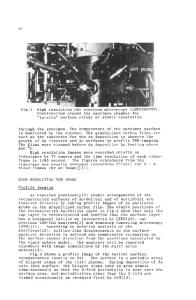Atomic resolution transmission electron microscopy of surfaces
- PDF / 1,788,540 Bytes
- 9 Pages / 612 x 792 pts (letter) Page_size
- 54 Downloads / 423 Views
Atomic resolution transmission electron microscopy of surfaces Ann N. Chiaramonti and Laurence D. Marksa) Institute for Environmental Catalysis, Department of Materials Science and Engineering, Northwestern University, Evanston, Illinois 60208-3108 (Received 6 January 2005; accepted 9 March 2005)
A brief overview of transmission electron microscopy as it applies specifically to obtaining surface crystallographic information is presented. This review will encompass many of the practical aspects of obtaining surface crystal information from a transmission electron microscope, including equipment requirements, experimental techniques, sample preparation methods, data extraction and image processing, and complimentary techniques. I. INTRODUCTION
The atomic scale structures of crystalline surfaces play an important role in the overall properties of materials systems, especially those relating to heterogeneous catalysis, thin film growth, and the increasingly miniaturized world of micro electrical mechanical systems (MEMS). Nanoscale engineering of materials has become commonplace, and as technologies begin to emerge on smaller and smaller length scales, surface properties become increasingly more important relative to those of the bulk. The loss of coordination at the surface and the socalled “dangling bonds” that result increase the surface free energy and provide a driving force for the reconstruction of surfaces whose structure cannot be predicted from bulk thermodynamic arguments. This inability to predict the structure of surfaces a priori has necessitated a field of study devoted entirely to experimentally determining the surface atomic structure of materials. Only through the complete knowledge of the surface structure of materials can one truly understand the nature of the processes that play out on them. Since even in high-vacuum conditions surfaces are contaminated in seconds,1 to study the atomic structure of surfaces in a truly meaningful way ultrahigh vacuum (UHV) techniques are required. Although some surface reconstructions are stable in air (oxides, noble metals), hydrocarbons, moisture, and other atmospheric contaminants adsorb onto these surfaces and must be avoided. Finally, some reconstructions (those of semiconductors, for example) are stable only in UHV environments, so if a)
Address all correspondence to this author. e-mail: [email protected] DOI: 10.1557/JMR.2005.0211 J. Mater. Res., Vol. 20, No. 7, Jul 2005
http://journals.cambridge.org
Downloaded: 13 Mar 2015
one wishes to study these often interesting systems, in situ UHV techniques are required. The most common UHV techniques for studying the atomic scale crystal structure of surfaces in real space include scanning tunneling microscopy (STM), transmission electron microscopy (TEM) including highresolution electron microscopy (HREM), and scanning transmission electron microscopy (STEM). Several common reciprocal space techniques include low-energy electron diffraction (LEED), grazing incidence x-ray diffraction (GIXD), transmissio
Data Loading...











